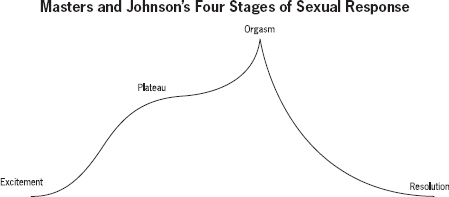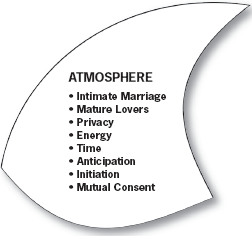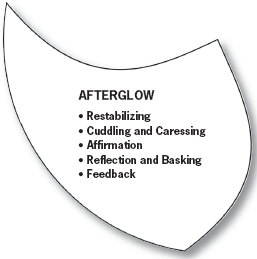

5

The Lovemaking Cycle
The Bible reveals that every part of man’s physical life is closely connected with sin or with salvation, and that anything that sin has put wrong, Jesus Christ can put right. We are dealing with soul as it expresses itself through the body. The organs of the body are used as indicators of the state of the spiritual life.
Oswald Chambers

“I just want you to know it’s embarrassing as heck to be here right now,” Daniel said with a bit of a smile. “If you had told me several years ago that I’d be sitting in a counselor’s office telling him about my sex life, I’d have said you were crazy. I figured I knew everything I needed to know about sex. I don’t mean I’m like Joe Stud or anything, but in my pre-Christian days I read Playboy sometimes, and I was more experienced than I should have been when I got married, if you know what I mean. I thought I was a pretty good lover, but my wife would probably tell you otherwise at this point.”
Daniel was a bright and immediately likeable guy. He was thirty-two years old, married for six years, and had a three-year-old son. He had come to see me on his own without any prompting from his wife—rather rare for a man. He quickly explained that his marriage was solid and that he loved his wife, Sandy, very much but was frustrated over feeling that he wasn’t a good lover. His primary complaint was premature ejaculation, which often left Sandy feeling neglected in their lovemaking.
As we talked, it became obvious that Dan had a fairly adolescent perspective of sex, which had been shaped largely by magazines and the locker-room wisdom of his non-Christian buddies. For years before his marriage, this adolescent perspective had been paired with periodic masturbation while fantasizing and occasionally using pornography. Sex was fairly physical for him and, though he did truly love Sandy, he was much more tuned into his enjoyment of her in the bedroom than into how he could please her. He wasn’t even particularly aware of what things turned her on, although he seemed to think she really liked his bikini briefs.
Over the next few sessions we explored various pieces of God’s vision for sexuality as presented in this book. Dan began to see sex as more than just a personal buzz, or as a pass/fail performance for his wife. He began to connect it with the rest of their relationship and to his relationship with God. In so doing, he discovered that he was less focused on himself and his own pleasure in bed. His adolescent view of sex matured into seeing it as a powerful means of expressing his love for Sandy. He began to talk more openly with her and to discover her likes and dislikes. (What a shock to learn that she didn’t particularly like his bikini briefs!)
Sandy eventually insisted on joining him in our sessions because she couldn’t believe what a change had taken place, not just in their sex life but in the way he was treating her throughout the day. “He’s really changing, and I can hardly believe it,” she said. “It’s like I’m getting a new husband! He’s even showing a greater interest in spiritual things. I feel more connected to Danny and like I’m getting to know a side of him I never saw before. I knew it was in there, but it seemed buried or something.”
Dan’s willingness to seek help for a relatively simple sexual complaint opened a precious window for growth in himself and his marriage. A real maturation process took place. He found that by being more tuned into Sandy in the bedroom and allowing sex to become more relational instead of purely physical, not only did he have greater control over his climaxes, but Sandy began to initiate lovemaking—something she had never done before.
“It’s like I finally get what sex is about,” Dan said in one of our final sessions. “I can’t believe that after almost seven years together we can be enjoying each other more now than we did on our honeymoon.”
“It’s true,” Sandy confirmed. “Our sex life and our whole marriage keeps getting better. One of my girlfriends at church last week commented that she wished her marriage was like ours!”

Daniel and Sandy experienced some of the transformational growth that can occur when a couple begins to really work on their ability to love, honor, and cherish each other on every plane of their marriage, including the sexual. This is not an overstatement. The vulnerability of the marital bedroom makes it the ideal place for developing character and maturity as “iron sharpens iron” and couples learn to give and receive the most intimate expressions of love.
One of the primary tools I use with couples to help them catch a vision for this kind of relational transformation is a model I developed called the Lovemaking Cycle. It incorporates pieces of models developed by sex therapists and researchers over the past several decades but expands to address the relational and spiritual aspects of lovemaking that are the focus of this book.
Stages of Sexual Response
Dr. William Masters and Virginia Johnson are perhaps America’s most well-known sex researchers. Although their research methods were less than moral by Christian standards, their findings have provided the foundation for much of the subsequent work in this field. In Human Sexual Response (1966) they detailed four stages of sexual response that they identified as excitement, plateau, orgasm, and resolution. These stages are distinguished from one another by changes occurring in the male and female bodies throughout foreplay and intercourse. These stages can be represented graphically, as shown in the figure below, to give us a model of physiological sexual response.

Fig. 5.1
At each stage specific changes occur that help propel the body into the next stage. In excitement the heart rate and respiration of both partners increase significantly, often causing their skin to become slightly flushed. The penis, clitoris, and nipples become erect and the vagina begins to lubricate. The genitalia become fully prepared to facilitate intercourse. As penetration occurs and thrusting begins, the couples’ bodies reach a plateau of sorts in a highly aroused state, preparing for orgasm.
At the point of orgasm a group of muscles throughout the entire pubic region goes into involuntary spasm. Ejaculation occurs at this point in the male. Orgasm may occur for the woman during intercourse, but about two-thirds of all women require direct clitoral stimulation to achieve climax. This stimulation can be facilitated before, during, or after intercourse.
Immediately following orgasm the body transitions back to its prearousal state, which is called the resolution stage. Blood flow becomes less concentrated in the genitals, muscles relax, and respiration and cardiac function return to normal. The woman can be brought back to orgasm at this point, even multiple times, but the man’s body remains in a refractory phase during which a second orgasm is not immediately possible. (The length of this refractory phase generally increases with age, from a few minutes to as much as a few days.)
Not Just Having Sex
The Masters and Johnson model provides a helpful picture of how the body responds to sexual cues; it portrays how human beings function physiologically when having sex. But we are interested in making love, not simply having sex. God has much more in store for his children than just a physical rush. We want to plug this physiological model into a more comprehensive one that incorporates the mental, emotional, relational, and spiritual aspects of making love.
The Lovemaking Cycle is not linear but circular. It places sex within the context of a committed marital relationship and shows it flowing out of the love and intimacy a couple shares on every other plane of their marriage. Each phase or quadrant of their lovemaking flows into the next and feeds a continuation and deepening of their love.

Fig. 5.2
If the cycle is thought of as a wheel, and if each piece of the wheel is functioning as it should, a couple’s lovemaking will roll along nicely down the road of their lives together. Like exercising a muscle, their marital bond will be strengthened and their sense of oneness deepened each time they move through the cycle. Just as in physics, which states that an object in motion will remain in motion unless acted on by another force, the wheel of a couple’s lovemaking will tend to stay in motion throughout their years together unless acted on by some other force.
However, if a piece of their relationship or sexuality is impaired or missing in some way, the wheel of their lovemaking will “clunk” every time it hits that place. If the problem is not addressed, the wheel can eventually clunk to the point that lovemaking stops altogether. This was the case with many of the couples who came to my therapy office. Their relational intimacy had become impaired because of some issue they didn’t know how to work through, and the problem had worsened to the point that their love life had come to a standstill. Again, as in physics, an object at rest tends to stay at rest.
Many times all that is required to get the wheel of lovemaking rolling again is to address a few key areas. This model becomes helpful, then, not only in offering a vision of what lovemaking can be but in providing a diagnostic tool for determining where problems may be impairing the lovemaking process. These problems can be targeted for healing and growth so a couple’s love life becomes everything God intends it to be.
A quick overview of the model will help to clarify it, and the next four chapters will explore each of the quadrants in far greater detail. True lovemaking always begins within a healthy and God-honoring context or Atmosphere. This can occur only within a covenantal marriage as was discussed in chapter 3—not within a dating relationship or for a couple that is living together, which God calls fornication; not within a homosexual relationship, which God calls an abomination; and not within a relationship outside of marriage, which God calls adultery. It can occur only when one man and one woman are in a covenant marriage for life.
That is not the only requirement for a healthy Atmosphere, however. There are many Christian couples whose marriages and lives are anything but conducive to an intimate and fulfilling sex life. A couple must be mature and able to share intimately on all other planes of their relationship. As the title of the classic book by Dr. Kevin Leman suggests, Sex Begins in the Kitchen—Because Love Is an All-Day Affair. Sexual love should always be a confirmation of the love that has been expressed throughout the day.

Fig. 5.3
A couple must also have healthy boundaries around their privacy, energy, and time. They must allow themselves to mentally anticipate and prepare for their times of sexual intimacy. They need to be able to talk about their desires and at times negotiate with each other when their interests vary. There must be mutual respect that never allows sex to become an issue of control or a weapon used to punish the other.
When the key ingredients of a healthy, godly Atmosphere are in place and when a couple has mutually consented to a specific time of lovemaking, they will roll into the second quadrant of the model, Arousal. Here they will tune into their own and their partner’s body in a spirit of playfulness, as clothing is removed and they explore each other. Allowing various stimuli to flood their senses, they will talk and tease and connect with each other’s body, soul, and spirit, becoming physically, emotionally, and spiritually naked and vulnerable. While embracing the gift of their sexuality and inviting their passion to build, they spill naturally down into the third quadrant.

Fig. 5.4
The third quadrant, called the Apex, is marked by the couple abandoning themselves to lovemaking, allowing their passion to carry them to a point of tremendous connectedness. They lose all inhibitions as their bodies are joined and they surrender themselves completely to climax. Time seems to stand still for a few precious moments. They are alone as one.

Fig. 5.5
The Apex is followed immediately by a phase I call Afterglow. This is a period when the partners collect themselves after their experience of surrender. It corresponds physiologically to Masters and Johnson’s resolution stage, when the couple’s bodies are returning to normal. During this phase, there is a wonderful opportunity for the lovers to bask in what they have just shared by cuddling, caressing, and verbally affirming the love they have communicated with their bodies. It is a time of soaking up the joy of their oneness and reflecting on the relationship, becoming aware at an even deeper level of how intimate the marriage has become. The two praise each other and compare notes on what they enjoyed and perhaps what they wish to change next time. This basking and sharing encourages them to make provision for lovemaking again as they return to the Atmosphere quadrant.

Fig. 5.6
Our purpose here is to provide only a brief overview of the Lovemaking Cycle—a picture of what couples can experience in their sexuality. We will now begin to look at each quadrant in detail and identify keys to enhancing the function of each, as well as point out problem areas and suggest ways to alleviate them. Lovemaking is filled with opportunities for ever-deepening experiences of oneness but is also fraught with potential for breakdowns and disconnection. We encourage you to read through the following chapters in order and to discuss them as a couple in pursuit of more of the fullness of God’s plan for your sexual union.

Questions for Couples
 Are there ways in which immaturity and self-centeredness are keeping your lovemaking stuck at a fairly physical level?
Are there ways in which immaturity and self-centeredness are keeping your lovemaking stuck at a fairly physical level?
 At what point(s) does sexual intercourse feel most connected to the rest of your relationship? When does it feel most disconnected?
At what point(s) does sexual intercourse feel most connected to the rest of your relationship? When does it feel most disconnected?
 Are you committed to beginning a more open dialogue about your sex life as a couple?
Are you committed to beginning a more open dialogue about your sex life as a couple?
 What aspect(s) of lovemaking would you most like to improve as you continue reading?
What aspect(s) of lovemaking would you most like to improve as you continue reading?